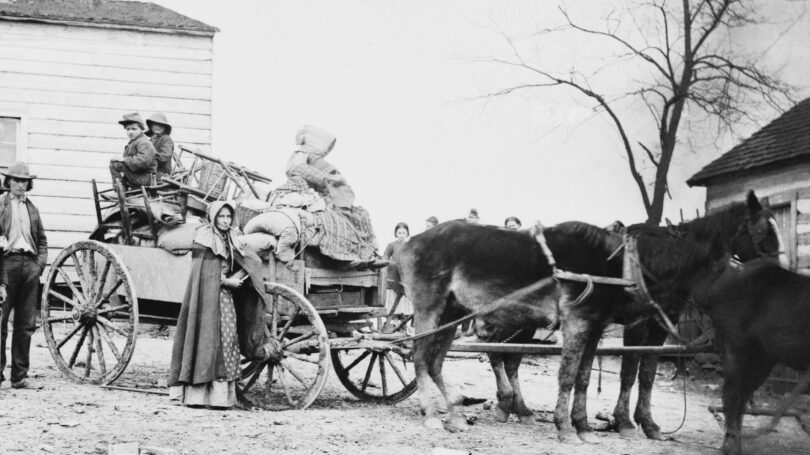Country wisdom is the collection of practical experiences gained by generations of pioneers, farmers, and ranchers as America transformed from a vast frontier to the world’s greatest economy. That experience – the result of constant trial and error – was passed from parent to child in plain language that left no room for misinterpretation. Living on a farm or ranch miles from the nearest neighbor meant solving problems on your own, making do with the materials around you, and accepting whatever happened and moving on.
Country people know that worry is like riding a rocking horse – it’s something to do, but gets you nowhere. Excuses and explanations count for little if the seed is not in the ground by the spring rains to make a crop. You don’t blame the cow when the milk gets sour, but change the pasture where she eats.
Country Sayings to Invest By
The wisdom gained over years of self-reliance in a lonely, often hostile environment remains just as applicable today in our modern, urban setting as at the turn of the century. The lessons of a country life – expressed in simple, understandable language – are especially pertinent for a beginning or inexperienced investor seeking to negotiate a confusing, constantly changing terrain of potential investments and prices. The following country proverbs are tested and true bits of wisdom you can apply equally to your investments and your life.
1. “The Quickest Way to Double Your Money Is to Fold It Over and Put It In Your Pocket”
Everyone expects to make money in the stock market, but few have realistic expectations of probable returns. Inexperienced investors frequently buy stocks on the advice of acquaintances or friends who brag about their experiences, implying that investment success is easy.
Everyone expects to buy the next Apple or Microsoft, allowing them to retire at age 30 or 35. However, doubling your money in a single year is highly unlikely, and becoming wealthy overnight a pipe dream for most people.
Here are two keys to stock market success and long-term financial independence:
- Spend Less Than You Earn and Save the Difference. Broke is what happens when a cowboy lets his yearnin’ get ahead of his earnin’. Many people confuse a “want” with a “need,” and consequently spend all that they earn (plus what they can borrow through credit cards and loans) to maintain a lifestyle they cannot afford. As a result, they live paycheck to paycheck with the constant stress of money problems. If you are struggling to save money each month or to reduce mounting credit card debt, make a budget and downsize your life.
- Save Regularly Over Long Periods of Time. Warren Buffett, considered by many to be the greatest modern investor, recognized the link between time and investing success. According to the Sage of Omaha, “No matter how great the talent or effort, some things just take time. You can’t produce a baby in one month by getting nine women pregnant.” Saving a dollar a day ($30 per month) will grow to $3,600 in 10 years, $7,200 in 20 years, and $10,800 in 30 years. Investing those savings at a rate of 5% per year increases your total savings to $4,677 in 10 years, $12,382 in 20 years, and $25,072 in 30 years.
Investing more money over longer periods builds even greater capital accumulations. A person who earns $50,000 per year and invests $5,500 per year in an IRA that earns 5.6% per year can grow an investment account of $71, 147 in 10 years. In 20 years, the total will be $193,833, and in 30 years, $405,393. Start saving and take advantage of compound interest to achieve financial independence.

2. “A Drought Usually Ends With a Flood”
The weather, world economies, and the prices of stocks are constantly changing, cycling through ups and downs. These cycles are often beyond the control of a single person or country. Understanding that cycles always end – whether droughts, recessions, or bear markets – is a prerequisite to successful investing.
The securities of good companies that grow revenues and profits during all kinds of economies often recover over the long term. The key to investing success is buying low and selling high, finding bargains when others are too afraid to take action, and sometimes holding an investment through lean times – even when the stock has lost money.
If your reasons for being invested remain, don’t shoot yourself in the foot by cutting out too soon. And if you’re caught on the adverse side of a cycle, use the time to prepare for the recovery – in other words, look for bargains while others wallow in their misfortune, too afraid to take action.
3. “If You Climb in the Saddle, Be Ready for the Ride”
All investments come with the risk that you could lose some or all of your money. Understanding the characteristics and history of a potential investment, in addition to your personal tolerance for risk, is essential whether you will be in the market short or long-term.
Individual stock prices and the values of composite stock market indexes are constantly fluctuating, moving up and down in reaction to supply and demand. In the short term, price movement is affected by the news, rumors, misinformation, and emotions. As a result, prices are more volatile in the short term, so purchasing a stock hoping for a quick return is just as likely to produce a loss as a gain.
Country people know you don’t go in if you don’t know the way out. Do not make investments in desperation or fear. Do your homework and have faith in your decisions. Knowing why you made the investment in the first place is essential to understanding when it is time to sell.
For example, a reason to buy stock in ABC Corporation could be a history of continuous annual profits and a regular dividend. If profits disappear or the dividend is cut after you’ve made the purchase, it’s time to examine whether continuing to own the stock is appropriate.
Similarly, if you buy a stock anticipating an announcement of a new product within the following month, sell the stock either when the announcement is made or when it becomes clear that an announcement will not be made. Keeping any investment without knowing why you own it is a sure path to emotional stress and financial loss.
4. “Never Eat Your Laying Hens”
Never forget that your work with a salary or wages is the goose that lays the golden eggs. It is always in your best interest to be a good employee, enjoying raises and promotions as your career progresses. Sometimes, it may be more prudent to invest in yourself with extra training or education than to invest elsewhere. Don’t let your outside investments distract you from excelling at the real source of your income – your job – until such time that your investments provide more regular income to you than your employer.
In addition, before making stock market investments, be sure you’ve taken care of your insurance needs – health, disability, life, homeowners, and liability – and have built an emergency savings account. Insurance covers the uncontrollable risks that each of us face and protects against potentially devastating consequences. A savings account equal to three to six months of your net income minimally ensures that you can meet emergencies without having to sell long-term investments prematurely. Just as the farmer depends upon his or her hens for a source of daily food (eggs) to avoid starvation, proper insurance coverage and an adequate savings account can allow you to assume the risks that accompany stock market investments.
While insurance ownership and an adequate savings account are the foundations upon which to build personal wealth, opening and regularly contributing to tax-favored investment plans is equally important. Tax laws provide a variety of programs that allow funds to grow without the burden of taxes or expenses to be paid with pre-tax dollars. For example, retirement funds can be accumulated with 401k and IRA plans, future college expenses can be set aside with an ESA or 529 plan, and health care costs can be covered with health savings accounts (HSAs).
Unfortunately, many people invade their tax-deferred plans prematurely, withdrawing principal and earnings to pay for daily living or to meet emergencies for which they were not prepared. As a consequence, they lose tax advantages, may be subject to financial penalties, and interrupt the advantage of compounding interest. This practice is similar to the farmer eating his or her laying hens or seed corn – the long-term consequences can be catastrophic.

5. “Build Your Fence Before You Plant Your Crops”
Adequate preparation is essential to every success, whether on the frontier or in the chaos of the stock market. A farmer who sows seeds without protecting the emerging seedlings is likely to lose the crop to marauding cattle and wildlife. An investor who depends upon luck, tips, and touts is likely to lose the capital invested.
Take the time to do your homework before making an investment. Just because a chicken has wings doesn’t mean it can fly. Not all stocks and bonds are good investments, despite what well-intentioned friends and commission brokers might say.
At a minimum, you should understand the basics of investing:
Alternative Investments
There are a plethora of possible investments available to anyone with excess cash. They range from equity and debt securities of individual companies traded on one of the stock exchanges or over-the-counter, to managed and unmanaged collections of securities (mutual funds). There are investment funds designed to parallel the movement of market indexes (ETFs), options to buy or sell securities for a predetermined price over a specific period of time, and futures to buy and sell basic commodities such as corn, wheat, or petroleum.
Each investment type has its own risk/reward parameters and individual nuances.
Basic Market Indicators
Investors measure and compare investments in a variety of ratios and calculations. Every potential investor should understand the calculation and use of such indicators, including common market indexes (such as the NASDAQ Composite, Dow Jones Industrial Average, and S&P 500), earnings per share (EPS), price-earnings ratio (PE), debt to equity ratio, current ratio (calculated by dividing current assets by current debt), price and volume trends, support and resistance levels (a stock that moves regularly between $10 and $15 would have a support level of $10 and a resistance level of $15), and moving averages (the visual pattern of the average security price over a specific period of time).
Types of Stock Analyses
Investors use a variety of methods to analyze the value of stocks of specific companies or to project future price levels. Many long-term investors, following the example of the aforementioned Warren Buffett, use fundamental analysis to identify potential investments. Their analysis is based upon the operations of a business and its future prospects with the goal of defining the company’s real underlying value. This value is then compared to the market value to determine whether to buy or sell the security.
Traders on the other hand – investors whose intended investment period is short-term – are not typically concerned with the underlying real value of a company’s securities, focusing entirely on its future price movement. Traders understand that prices of securities in the short term move on the emotions of possible buyers and the current owners, and rely on technical analysis to determine when to buy and sell. By analyzing past price movements with their associated volume, often with visual charts depicting that information, they project future prices and react accordingly. Traders typically hold their investments less than six months; a special breed – day traders – buy and sell large positions within a single trading period.
Mechanics of Buying and Selling
The financial industry is heavily regulated, and while some stocks may be purchased without a broker, the vast majority of transactions occur through a brokerage firm. Brokers can be full-service or discount, the difference being the type and level of services provided in addition to executing orders to buy and sell. Commissions usually vary according to the services provided to the customers and the size of the order. And orders may be executed over the phone by a licensed stockbroker, or more commonly, by the investor via a discount brokerage’s trading platform online.
Potential investors should be knowledgeable about the requirements and mechanics of opening a brokerage account, minimum deposits required, the differences between cash and margin accounts, and how settlement dates differ from trade dates. In addition, an investor should know the types and uses of the various orders that can be placed to buy and sell securities including market, stop, and limit orders, as well as the time for which an order can remain in place.
As mentioned previously, stocks are extremely volatile in the short-term with a significant risk of loss. Country folk know you don’t dig up more snakes than you can kill. Don’t attempt to trade stocks unless and until you have plenty of experience in the market and the capital to bear the risk.

6. “Never Ask the Barber If You Need a Haircut”
With adequate preparation, you can ready yourself to make investments in the stock market or elsewhere. It is important to make your own decisions – even though many registered representatives have your interests in mind, they have an inevitable conflict of interest since their income likely depends upon the volume of transactions you execute. Registered representatives learn early in their career to have an investment recommendation ready at all times, usually originating from their firm’s bank of analysts and money managers.
Before blindly following your broker’s advice, do the analysis yourself, relying upon the tools and skills you developed during your preparation. Doing the work yourself gives you the confidence to stay the course if prices fall in the short term. When someone recommends a security, be sure you get the bacon without the sizzle – it might not smell as good, but you can be sure the idea is well-cooked before eating.
Final Word
Once you’ve begun to invest and have had some success, don’t forget the basics of your success. People have an uncanny ability to believe that success, once gained, can’t be lost. Making money consistently over a long period requires diligence, effort, intelligence, and patience, just as pioneers built communities in the West that have survived and thrived.
As we move away from our agrarian roots, the language might change, but the fundamental truths expressed in a country saying remain as true today as yesterday. You can take that to the bank, and hang your hat or bet the farm on it.
What other sayings can you think of that are relevant to investing?